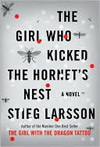 The Girl Who Kicked the Hornet’s Nest
The Girl Who Kicked the Hornet’s Nest
By Stieg Larsson
Alfred Knopf, 2010
The Girl Who Kicked the Hornet’s Nest concludes Stieg Larsson’s series of novels about investigative journalist Mikael Blomkvist and Lisbeth Salander, not because Larsson was finished with the subject but because he died before he could write the 10 novels he reportedly had planned.
I wondered, in my comments on the previous novel, The Girl Who Played with Fire, where Larsson was going with the series. Was it going to now focus on Lisbeth Salander or would it return to Mikael Blomkvist and Millenium magazine? The series appears to have been headed in the latter direction, with Blomkvist launching another investigation — this time into the injustices done to Salander by the state. The novel returns to Larsson’s broad themes about right-wing extremists, the role of a free press in a democracy, and violence against women. It’s kind of preachy.
Salander spends most of the novel in a hospital bed recovering from the wound she received in the last pages of the previous novel, so even though midway through The Girl Who Kicked the Hornet’s Nest she gains access to a computer and the Internet, her place in the novel is circumscribed. This is an interesting take on one of the tropes of crime fiction: the detective who for whatever reason is immobile and has to solve crimes by cerebration. (Rex Stout’s Nero Wolfe was such a detective.)
The first novel in this series introduced us to Salander, the second novel told us how Salander got that way, and this novel, by settling old scores with Salander’s enemies, clears the way for the next chapter in her life. The last sentence of the novel begins with the words, “She opened the door wide.” That metaphorical act tells us where this series was headed. I wish we could have the other seven novels.
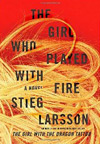 The Girl Who Played With Fire
The Girl Who Played With Fire
By Stieg Larsson
Vintage Crime/Black Lizard, 2010
In my comments on The Girl with the Dragon Tattoo, I said, “Let’s not kid ourselves: it’s the character of Lisbeth Salander that makes this book worth running out to read right away. In my view, she is clearly the most interesting female investigator in crime fiction today precisely because she is so ruthlessly amoral and portrayed as such so unapologetically until the end of this novel. I am eager to read the next one to see where Larsson goes with this character.”
The Girl Who Played with Fire doesn’t disappoint. Larsson’s first novel was about the reporter Mikael Blomkvist and his investigation into a corrupt businessman. Salander did some investigating for him, and she stole the show, but it was basically a novel about Blomkvist. This novel is about Salander. We learn where she came from and can begin to see how she got be to the way she is.
Two detective novelists in the American tradition have experimented with characters who, like Salander, first appear as ruthless, amoral warriors: Robert B. Parker’s Hawk and Robert Crais’ Joe Pike. The question for the author becomes whether, and if so how, to develop this character. Parker appeared content to let Hawk be Hawk. We don’t hear about his childhood, his friends (if any), never see the inside of his house, and so forth. Crais has taken a different route with Joe Pike both in L.A. Requiem and The Watchman, revealing his past and showing a capacity for sympathy and understanding that expands his character.
Larsson seems to be headed down that latter road with his novel, which is about Salander, not Blomkvist. We learn about her father, her mother, how she came to be under guardianship of the state. We see that she’s capable of human empathy in her treatment of her former guardian, a stroke victim. Her relationship with Miriam Wu seems to suggest that she’s capable of sustained human friendship. In many ways, we come to see her as a victim of her past, not a freak of nature.
There’s only one more Larsson novel. Where will he take this character?
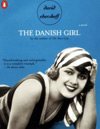 The Danish Girl
The Danish Girl
By David Ebershoff
Viking, 2000
This is a book I just picked off the reading room shelf in Rolvaag Library because the cover caught my eye. I had never heard of it, even though it was apparently an international best seller when it was published. This is why you should wander around the reading room from time to time.
The novel was inspired by the life of Einar Wegener, a Danish painter who became one of the first identifiable cases of surgical gender reassignment. The novel begins one day when Einar’s wife Greta, also a painter, asks him to put on women’s stockings and shoes and pose for her so that she can finish a portrait. Her female model had canceled that day, and she needed to do the legs. Einar complies, and thus begins the series of events that moves from Einar taking to dressing more and more often as a woman, to a forced departure from Denmark, to life in Paris, to a crisis, and to Einar’s decision, with his wife’s support, to go to Dresden for gender reassignment surgery. He emerges as Lili Elbe.
This is one of the most intimate novels I can remember reading. It’s not physical intimacy but rather a meticulous recounting of the sate of mind of someone going through this extraordinary set of experiences. Set in the 1920s, the novel also meticulously records details of daily life. At a street market in Paris the woman who sells fine skirts and blouses has chipped front teeth; Lili’s velvet cap features a yellow-diamond and onyx brooch shaped like a monarch butterfly. Reading the novel, you feel drawn further and further into the lives of the characters and the realia that surrounds them.
The novel surfaces an interesting paradox: Einar/Lili is presented throughout as weak and passive, yet he/she achieves extraordinary self-knowledge and acts upon that knowledge with extraordinary courage and determination. How could someone be at the same time so seemingly powerless and yet so brave?
This is a slow, meditative novel that will draw you into its interior space. I recommend it.
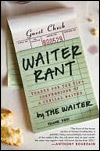 Waiter Rant: Thanks for the Tip — Confessions of a Cynical Waiter
Waiter Rant: Thanks for the Tip — Confessions of a Cynical Waiter
By Steve Dublanica
HarperCollins, 2008
I like books about food, cooking, and eating (see Julie and Julia: My Year of Cooking Dangerously by Julie Powell, Heat by Bill Buford, and In Defense of Food: An Eater’s Manifesto by Michael Pollan elsewhere on my bookshelf). For four years Dublanica anonymously chronicled his experiences as a waiter on a blog called “Waiter Rant” that ultimately won an award for best writing of a blog. This book grew out of that blog.
It’s about being a waiter. Like Anthony Bourdain’s Kitchen Confidential, which tells the story of what’s going on in the kitchen, Waiter’s Rant tells what’s going on among the wait staff. Both books present life in a restaurant as a frenetic, heart-pounding, eyeball-bulging experience. Food workers stay up too late, smoke too much, drink too much, do too many drugs, and lead messy lives. Restaurant owners are mean, greedy people with no managerial skills. Maybe it’s really like that.
Dublanica was a seminarian and then a mental health care worker before he began waiting tables, so he comes at his narrative with a kind of double-consciousness: on the one hand he’s a waiter, immersed in the adrenalin-charged business of getting food out to the table on time; on the other hand he’s standing apart from the other servers as someone with more education and more perspective — in short, as a writer. In one chapter near the end of the book he tells the story of how he eased a drunken customer out of the restaurant rather than serve her. A customer watching him says afterwards, “’You’re more than just a waiter. Aren’t you.’ ‘Yes, madam,’ I reply. ‘Yes, I am.’” (Dublanica is usually the hero of his own stories.)
There’s some fine writing in this book, but I was hoping that it would be a little less about how crummy the narrator’s co-workers were and a little more about the business of getting food on the table.
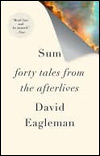 Sum: Forty Tales from the Afterlife
Sum: Forty Tales from the Afterlife
By David Eagleman
Pantheon Books, 2009
My friend Inga Velde ’75 read this book and passed it to me. It is short, puzzling, and quirky. I recommend it.
David Eagleman is a “neuroscientist and a writer.” He calls the chapters in Sum “Tales,” and that’s a good label for them. They postulate an imaginary situation connected to the afterlife, spin out in a narrative that shows what it would be like under those conditions, and then, typically, end with an ironic twist — like an O. Henry short story — that contains something like a moral.
The first tale, for example, imagines what it would be like if in the afterlife you relived all of your life experiences so that all of the similar experiences are grouped together. You would spend 27 hours in pain, 18 months waiting in line, 77 hours confused, and so on. The tale ends by noting that you would even spend a certain amount of time wondering what it would be like if your experiences were split into tiny, more tractable morsels “where moments to not endure, where one experiences the joy of jumping from one event to the next like a child hopping from spot to spot on the burning sand.” The point of this tale, I think, is to suggest that we should take pleasure in the episodic, fragmented nature of our experience.
Another tale begins by positing that the world of the afterlife is made up only of people you know, another that in the afterlife you can choose whatever you would like to be in the next life, another that God’s favorite book is Frankenstein, and so on. One of the blurbs on the book jacket has one Geoff Dyer asserting that “Sum has the unaccountable, jaw-dropping quality of genius.” I wouldn’t go that far by any means, but it is unexpected, witty, and thought-provoking.
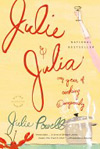 Julie and Julia: My Year of Cooking Dangerously
Julie and Julia: My Year of Cooking Dangerously
By Julie Powell
Little, Brown, 2005
I love good food, I love to cook, and I thought Julie and Julia was a great movie. I was in an airport before a long flight, saw the book, and bought it.
This is a memoir. Its narrative is framed around the Julia Project, the author’s decision to cook every recipe in Julia Childs’Mastering the Art of French Cooking, Volume I in a 365-day period. She chronicled that project in a blog and then wrote this book. It’s really not a book about cooking. It’s a book about not knowing who you are, being stuck in a dead-end job, being afraid that you are permanently stuck and that you will never know who you are, and about finding a way out of that trap.
It’s fun, mostly. While it’s not a cooking book per se, or a compendium of recipes, there are lots of cooking stories, enough recipes to keep you going, and lots of funny stories of kitchen mishaps. The narrative about finding out who you are seems less sustained, though it has moments of passion and brilliance. We’re told that the author found herself through this project, but it’s not clear how or whether that actually happened.
Like many young writers, Powell goes a long way by being hip, flip, and profane. Sometimes that’s really funny, as in this description of “the French paradox”: “that much-publicized puzzle of how French people eat all that fatty food and drink tons of wine, yet still manage to be svelte and sophisticated, not to mention cheese-eating surrender monkeys“(pp. 272-3). Other times it’s just vulgar and dumb, as in ”Please understand — I love my husband like a pig loves shit” (p. 18).
So, read this book if you are interested in a frequently amusing book about cooking. If you’re looking for a memoir about finding yourself—not so much.
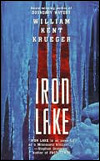 Iron Lake
Iron Lake
By William Kent Krueger
Pocket Books, 1998
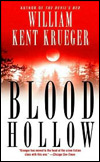 Blood Hollow
Blood Hollow
By William Kent Krueger
Atria Books, 2004
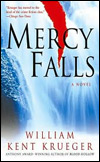 Mercy Falls
Mercy Falls
By William Kent Krueger
Atria Books, 2005
Greg Kneser, the excellent dean of students at St. Olaf, turned me on to William Kent Krueger, a Minnesota novelist who writes detective novels set in the Boundary Waters area. The detective, Corcoran O’Connor, is part Irish and part Anishinaabe Indian. He lives in Aurora, Minnesota (a thinly disguised Ely), with one foot in the town and the other in the nearby Ojibwe reservation. That’s not his only divided loyalty: he was the sheriff of Tamarack County, then he lost his job, then he won it back. So these novels are part police procedurals and part a variant of the tough-guy genre with a troubled, alienated individual with bad habits in dogged pursuit of a criminal. Then there’s Cork’s marriage to Jo, an attorney, which when it’s going well is a great thing and when it’s going badly is a real mess.
I recommend the Cork O’Connor novels for their evocation of the North Woods, their serious and respectful treatment of Native American traditions and culture, and their cold-eyed look at sin and evil.
<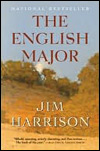 The English Major
The English Major
By Jim Harrison
Grove Press, 2008.
Why do people keep giving me books about English majors having midlife crises? And by “people,” here I mean my wife. Furthermore, when novelists want to write about adults misbehaving, why is it always the English major? What about the peccadilloes of chemistry majors, for example? Or economists? Surely they have some. Perhaps its because the people who write novels tend to have been English majors, and they write about what they know.
In any event, here’s a cranky novel about Cliff, who was an English major, taught high school English, left that profession to become a full-time farmer on his wife Vivian’s family farm, and then, at age 60, was left on his own when Vivian, who has become a “late-blooming real-estate shark” has an affair, sells the farm, and makes it clear that he is unwelcome. Cliff goes on a road trip.
He had a jigsaw puzzle as a child of the 48 states, and he resolves to visit all of them, throwing a piece of the puzzle away as he crosses each state border. Along the way he resolves to rename each state and its state bird. Renaming birds is the fun part of the novel. Bird names in general are preposterous — Rufous-sided Towhee for example, or Chestnut-vented Tit-Babbler — and in the course of the novel Cliff comes up with some excellent replacement suggestions for bird names.
But I digress. This is a book you might enjoy if you think we should pay more attention to place, you like road trips, you like narrators who are attuned to the landscape around them, you like descriptions of big hearty breakfasts, you like fishing, you don’t like cell phones, you think boats should be rowed rather than propelled by power motors, and you like lots of talk by the narrator about sex he is having, or used to have, or wants to have, mainly with younger women. Many of the blurbs describe the novel as “earthy.”
I found most of those aspects of the novel tiresome. But this is an interesting take on the novel of self-discovery. It begins with the blow to Cliff represented by losing his wife and the farm. He does what heroes have done for centuries in such a crisis — he takes to the road, has a series of adventures that put him in new situations and thus opportunities to grow, and ultimately comes home. Has he changed? Did he learn anything? That’s not clear. Earlier I called this a cranky novel. I debated while reading it whether the novel itself was cranky or merely its narrator. In the end, I think it was the novel.
 Gorbachev’s American Spy
Gorbachev’s American Spy
By Jeffery Barnett
Basil Road Books, 2010
This novella by my friend Jeffery Barnett, an immensely cultivated and interesting man, is part historical fiction, part political thriller. It tells the story of an unlikely relationship between Mikhail Gorbachev and an American military intelligence officer, Mike Shea. The author might have titled it “Mike and Mikhail.” It’s a fun and quick read. Imagine a story that spans nearly twenty years, touches upon the Soviet invasion of Czechoslovakia, Nixon’s visit to China, the Yom Kippur War, and offers insights into the Byzantine workings of the inner circles of the Communist Party during the Cold War. Highly recommended.
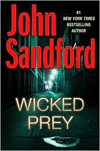 Wicked Prey
Wicked Prey
By John Sandford
G.P. Putnam’s Sons, 2009
It’s always a big day when I get my hands on a new John Sandford novel. It’s like sitting down to a piece of homemade raspberry pie topped with fresh cream: you want to devour the whole thing right away, except that then it will be all gone.
Wicked Prey is set during the Republican National Convention in Minneapolis, and it’s an interesting blend of political thriller and detective novel. There are really three plots going on here: the gang that is robbing political operatives of their walking around money; the depressing story of a mean-spirited petty criminal and his abusive relationship with a young woman; and the story of Letty, Lucas Davenport’s ward, who is growing up too fast and is just like Lucas. It’s a lot to juggle, and sometimes you feel like you’re reading a couple of different novels at once.
It’s interesting to watch what the writers of great series detectives — Robert B. Parker, Sue Grafton, even the venerable Rex Stout — do when they get into the middle of their series. They look for new directions without abandoning what’s working. Parker, for example, is keeping up the Spenser series while starting a new series featuring Jesse Stone and another new series featuring Sunny Randall, and now he is integrating characters from one series into the others. Stone and Sunny Randall have begun a relationship, and it seems inevitable that at some point Stone and Spenser are going to confront each other. Sandford also has two other series going, the Kidd novels and now the Virgil Flowers novels. The Prey novels and the Flowers novels have interlacing characters.
The most interesting part of Wicked Prey for me was the treatment of Letty. She is clearly going to be a force in future Prey novels, and the male-female, father-daughter dynamic that Sandford has set up is going to be fun to watch.
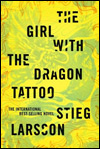 The Girl With The Dragon Tattoo
The Girl With The Dragon Tattoo
By Stieg Larsson
(translated from Swedish by Reg Keeland)
Vintage Crime/Black Lizard, 2009
I’m continuing my exploration of Scandinavian crime fiction. According to a note at the beginning of this novel, the author died in 2004 shortly after sending the manuscripts for this novel and two others to the publishers. One of the other novels is called The Girl Who Played With Fire. The other is untitled. Thus, his entire corpus of crime novels consists of these three works.
This is an intricately plotted novel because it is telling more than one story at once. There is the story of “Carl” Mikael Blomkvist, a financial journalist and co-founder (with his lover, a wealthy married woman) of a center-left magazine who has just been convicted of libel; the story of Lisbeth Salander, a ward of the state with an appalling life story, amazing investigative skills, and the morals of a cat; and the crime that brings them together, a forty-year-old missing person story involving the family of a prominent Swedish industrialist. It sounds unmanageable, but it isn’t. Larsson tells a compelling story about a crime and an investigation while developing two fascinating characters, Mikael and Lisbeth, and offering a critique of modern capitalism that resonates in light of the recent economic downturn.
But let’s not kid ourselves: it’s the character of Lisbeth Salander that makes this book worth running out to read right away. In my view, she is clearly the most interesting female investigator in crime fiction today precisely because she is so ruthlessly amoral and portrayed as such so unapologetically until the end of this novel. I am eager to read the next one to see where Larsson goes with this character.
This is a gritty novel. Gosh, the Scandinavians are dark! (And I can’t believe how much coffee gets drunk in this novel. How do they ever get to sleep?) If you’re offended by graphic depictions of brutal sexuality, don’t read this book. But if you accept that as a convention of this kind of fiction and you want to encounter a truly novel female character in a crime novel, read this one.
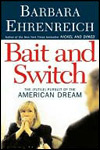 Bait and Switch: The (Futile) Pursuit of the American Dream
Bait and Switch: The (Futile) Pursuit of the American Dream
By Barbara Ehrenreich
Metropolitan Books, 2005
This book caught my eye at the public library. I’d read Ehrenreich’s Nickel and Dimed, in which she reports on the lives of low-wage earners by taking a series of such jobs. This book adopts a similar approach to a different group: white-collar unemployed. Ehrenreich creates a new identity for herself and then tries to get a job in corporate public relations. In the course of her search she seeks the help of resume writers and career coaches, attends networking events and job fairs, joins professional associations, and even gets a style makeover, but in the end she is unable to find a job as she defined it for the purposes of this book: a reasonable middle-class salary, benefits, an office from which to work.
This was a timely book when it was published in 2005: it is much more so today, when we are in the grip of the worst economic downturn since the Great Depression and unemployment the day I am writing this stands at 9.7 percent. General Motors emerged from bankruptcy last week announcing that, among other things, it would cut more than 6,000 white-collar jobs. Many Americans today are in precisely the situation Ehrenreich examines in her book, and reducing unemployment is undoubtedly one of the keys to emerging from this downturn. I wish this book were more helpful, but it’s mostly interested in excoriating the institutions Ehrenreich blames for the plight of the white-collar unemployed and the “transition” industry to which the unemployed turn for help.
Ehrenreich comes at her topic from a distinct point of view. She argues that the white-collar unemployed have done the things that are supposed to lead to success. They earned college degrees and worked successfully in meaningful jobs. They have skills, experience, and professional accomplishments. They are supposed to be living the American Dream. That’s the “bait.” But in a tough economic environment (Ehrenreich’s book grows out of the recession in the early 2000s), businesses and corporations cut costs by downsizing, “rightsizing,” and outsourcing. The workforce gets smaller, salaries and benefits get cut, and people who have skills, experience, and accomplishments find themselves not comfortable in mid-career but unemployed. They are supposed to be valued employees, but instead they are disposable. That’s the “switch.” This book describes what it’s like to be in that situation. To be fair, it does close with a solution. The best thing would be a return to fuller employment. The next best thing would be an expansion of benefits, such as universal health-care and expanded unemployment benefits to assist workers in transition. But Ehrenreich admits these solutions are “unlikely or even utopian in the current political climate,” which brings her to what is possible: self-defense. She argues that, “No group is better situated, or perhaps better motivated, to lead the defense of the middle class than the unemployed — assuming they could recognize their common interests and begin to act as a political force” (p.236). (The political climate in 2009 obviously differs from the one Ehrenreich wrote in: at least one of her “utopian” ideas, expanded health insurance for all Americans, is under serious consideration in the House and Senate today.)
The publisher’s blurb on the jacket of this book calls it “alternately hilarious and tragic.” I would call it “alternately self-righteous and mean.” Here’s an example. Ehrenreich has been working with a job coach, who does seem pretty ineffectual, and one day she decides to use a coaching session to try to persuade him that he needs to hire her as his PR person. She recounts that experience and then, driving home, observes:
I make my way back down the freeway toward the hotel, aware of all
the feelings appropriate to a pacifist on the occasion of his first kill.
Yes, I am filled with self-loathing and disgust. Slime oozes from my
hands onto the steering wheel; the white noise of the road is filled with
muffled denunciations and curses brought down on my soul. But I did,
didn’t I? I tried selling myself, and for an hour-long stretch I wasn’t
half bad. I have blooded my sword. (p. 120)
This is fancy writing, but it’s silly. Trying to persuade someone to hire you isn’t a mortal sin. This passage reflects Ehrenreich’s view of what she calls the “corporate world.” She’s so certain of its failings (and of her own superiority to it), that she can’t deliver much insight into it.
There’s good reporting in this book, and good writing. I recommend it to those who agree with, or can put up with, the agenda.
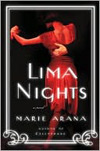 Lima Nights
Lima Nights
By Marie AranaDial Press, 2009
This is another book I picked off the shelf of new books at Rolvaag Library, not knowing anything about the author. I’m trying to be adventurous in my fiction reading. Set in Peru, it tells a story that, though familiar in many ways, holds your attention with exoticism that is curiously mixed with a hard-edged realism.
Carlos Bluhm is a middle-aged man, descended from wealthy German immigrants, married to Sophie Westermann, also descended from German immigrants, with two sons. Carlos has not been as successful as his father and grandfather, so he and his family live in faded splendor — they still belong to the exclusive Club Germania, for example, but only because his grandfather was one of its founders, not because they can afford it.
One night after a social evening with their wives at Club Germania, Carlos and his male friends go to a place called Lima Nights. There, women wearing red collars around their necks are available as dance partners. A young woman approaches Carlos and utters the novel’s first sentence: “Give me your hand.” She is beautiful, erotic, dark-skinned, and 15. You can see where this is headed, and that is indeed where it goes. Carlos embarks on a passionate affair with the young woman, Maria Fernandez, they are discovered, and his wife and sons leave him. Maria moves into the house and for the next 20 years they live together, unmarried.
Bluhm ran with the wrong crowd. His married male friends were promiscuous, but even in that context he was known as someone who turned to indigenous women for his affairs. The novel is brutally frank in its explanation for Bluhm’s preference: “It wasn’t the fragrant skin, the tiny toes, the thick black hair. An Indian woman was more disposable. It was a matter of convenience. And Bluhm’s friends understood this about him very well” (p. 19).
Maria is “disposable” not only because of her race but also because of her class. She lives in one of Lima’s worst slums, her father has died, and her mother takes in laundry for a nearby prison. There’s a different abusive man in her mother’s bed every night. When Bluhm arranges to pick Maria up on a street corner early in their affair, it’s the first time she has ridden in a car. He represents her path out of that life.
The question ultimately posed by this novel is whether Maria is, indeed, “disposable.” After she and Bluhm have been living together for 20 years she begins to worry that he has made no commitment to her, that he could throw her out on the street at any moment, and that she would be right back where she started when she first approached him at Lima Nights. I don’t want to give away the plot, so I’ll simply say that she begins a campaign for commitment, Bluhm responds, and things end badly.
The novel’s depiction of the culture of German Peruvians, its fascinating glimpses into the world of videntes, or fortune-tellers, its evocation of passion, its hard-eyed analysis of privilege and abject poverty — all these are compelling. The characters I found less so. I don’t understand what happened at the end.
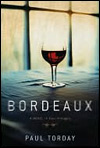 Bordeaux: A Novel in Four Vintages
Bordeaux: A Novel in Four Vintages
By Paul Torday
Houghton Mifflin Harcourt, 2009
I was in Rolvaag Library looking for a book to read, and — judging a book by its cover, which you’re not supposed to do — grabbed this one. I’m glad I did.
The novel has four sections (the “vintages” referred to in the subtitle), each prefaced with a date: 2006, 2004, 2003, and 2002. This is the order in which they occur in the novel, so you begin the story at the end, so to speak, and in the course of reading the novel come to understand how the situation with which you started came to be. Bordeaux unfolds, in this way, somewhat like a mystery novel where you begin with a murder and as the detective learns who committed it, so do you.
In this case, however, there isn’t a detective, nor is there an omniscient narrator. Bordeaux is narrated in the first-person by its protagonist, Francis Wilberforce. First-person dramatized narrators are always tricky. You have to take everything they say with a grain of salt because they are in the story — it happened to them — and they may well not understand what happened, or they may slant their interpretation of events to serve their own interests. That certainly happens in this novel. Wilberforce is not someone you will like, though you may at various points feel sorry for him. Raised in a loveless home by foster parents, utterly lacking not only in social skills but in social instincts, naïve about people and relationships, alcoholic — this is neither a recipe for a happy life nor the description of someone likely to bring happiness into the lives of others.
This novel reminded me of Evelyn Waugh’s Brideshead Revisited because it also tells the story of a solitary young man who is taken up by a wealthy, upper-class set and it doesn’t go well, particularly in matters of the heart. Here’s Wilberforce’s reaction to his first visit to Hartlepool Hall:
I imagined the world inhabited by these people to be like a garden surrounded by a high wall: inside the garden, the few inhabitants allowed to enter it enjoyed a life of leisure, in surroundings that were pleasant to the eye; outside, the world trudged about its weary business. I had been allowed a glimpse of the garden through the railings, had even stepped inside for a moment, and it had unsettled me. (p. 267)
This “unsettling” is very important. Indeed, it is at the heart of the novel, which you could think of as the story of how Wilberforce gets unsettled and what he then does. Here’s a hint as to how Wilberforce gets unsettled. It’s from an interior monologue as he sits watching a glorious sunset on the moors after his first grouse hunt with his new friends. He’s just overheard himself described by one of them as a “Nobody,” and at first it’s crushing, but then he thinks:
Because I am nobody, I can choose to be whom I like. I can choose my life to be what I want it to be. I can become anybody. I can do anything . . . . It is a matter of choice, a matter of understanding that one’s freedom to choose is limited only by courage and imagination . . . . All I have to do is stretch out my hand and take the thing I want. (p. 307).
The novel depicts that happening.
I wouldn’t read this book if you an oenophile looking for a wine-themed novel. There are a lot of wine names tossed around, some compelling descriptions of how fine wines taste, a depressing portrait of alcoholism, thoughts about wine collecting (“you own the wine; don’t let the wine own you”), but at the end of the day this isn’t a novel about wine. The love of wine is a symptom.
Bordeaux is a disciplined novel: tautly written in spare prose, carefully constructed, complex in its atmosphere and tone. I admired the craft as I was reading it, and I think you will too.
MORE
You must be logged in to post a comment.